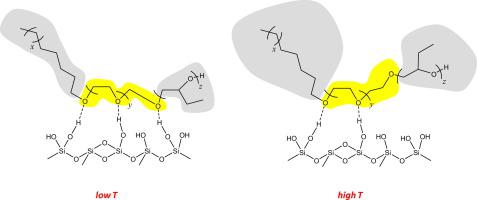Journal of Colloid and Interface Science ( IF 9.4 ) Pub Date : 2020-07-25 , DOI: 10.1016/j.jcis.2020.07.101 Kebede Beshah 1 , Robert Campbell 1 , Florin Dan 1 , Edward Daugs 1 , James DeFelippis 1 , Junsi Gu 1 , Eric Wasserman 1 , Wenshiue Owen Young 1

|
Hypothesis
Nonionic surfactants have been widely used for many consumer products and industrial processes, and their applications often involve temperature-cycling across cloud point temperature (Tcloud). To explore the behavior of nonionic surfactants across Tcloud and when mixed with colloidal silica at a very dilute concentration around 0.1 wt%, a series of 1,2-epoxybutane-capped alcohol ethoxylates (BAEs) with various cloud points is used as a model system.
Experiments
BAEs with cloud points from 15 to 64 °C were successfully prepared by varying the lengths of 1,2-epoxybutane (BO) and ethylene oxide (EO) blocks and their phase behavior across Tcloud was studied using nuclear magnetic resonance spectroscopy (NMR), dynamic light scattering (DLS) and differential scanning calorimetry (DSC).
Findings
In the absence of silica, the NMR signals are not greatly affected by the cloud point transition, but both the water and surfactant exhibit a decrease in spin-spin relaxation time once the temperature reaches the Tcloud. In the presence of silica, the NMR spectra indicate significantly reduced mobility of the EO portion relative to the alkyl and BO segments. Furthermore, our results suggest that the BAE surfactants are not fractionally clouding out or precipitating with a portion of the compositional distribution during the cloud point transition.
中文翻译:

深入了解环氧乙烷-1,2-环氧丁烷二嵌段共聚物在水中的行为随温度和胶体二氧化硅的存在而变化的情况。
假设
非离子表面活性剂已广泛用于许多消费品和工业过程,其应用通常涉及跨浊点温度(T cloud)的温度循环。为了探索非离子表面活性剂在T浊中的行为,并以约0.1 wt%的非常稀的浓度与胶体二氧化硅混合时,使用一系列具有各种浊点的1,2-环氧丁烷封端的醇乙氧基化物(BAE)作为模型系统。
实验
通过改变1,2-环氧丁烷(BO)和环氧乙烷(EO)嵌段的长度,成功制备了浊点为15至64°C的BAE,并使用核磁共振波谱(NMR)研究了它们在T云上的相行为。,动态光散射(DLS)和差示扫描量热法(DSC)。
发现
在不存在二氧化硅的情况下,NMR信号不受浊点转变的影响很大,但是一旦温度达到T cloud,水和表面活性剂的自旋-自旋弛豫时间就会减少。在二氧化硅的存在下,NMR光谱表明相对于烷基和BO链段,EO部分的迁移率显着降低。此外,我们的结果表明,BAE表面活性剂在浊点转变过程中不会部分混浊或与一部分成分分布一起沉淀。










































 京公网安备 11010802027423号
京公网安备 11010802027423号